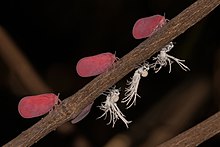
The Auchenorrhyncha suborder of the Hemiptera contains most of the familiar members of what was called the "Homoptera" – groups such as cicadas, leafhoppers, treehoppers, planthoppers, and spittlebugs. The aphids and scale insects are the other well-known "Homoptera", and they are in the suborder Sternorrhyncha.

The Cixiidae are a family of fulgoroid insects, one of many families commonly known as planthoppers, distributed worldwide and comprising more than 2,000 species from over 150 genera.

Eurybrachidae is a small family of planthoppers with species occurring in parts of Asia, Australia and Africa. They are remarkable for the sophistication of their automimicry.

Ricaniidae is a family of planthopper insects, containing over 400 species worldwide. The highest diversity is in tropical Africa and Asia and in Australia, with a few species occurring in the Palearctic and Neotropical realms. It is one of the smaller families in the planthopper superfamily Fulgoroidea.

Dictyopharidae is a family of planthoppers, related to the Fulgoridae. The family comprises nearly 760 species in more than 150 genera which are grouped into two subfamilies, Dictyopharinae and Orgeriinae.

Flatidae are a family of fulgoroid planthoppers. They are cosmopolitan in distribution and are distinguished from others in the superfamily by a combination of characters. Like all other planthoppers, they suck phloem sap of plants. Some species are known to communicate with vibrations through the plant stems. Communication may be with mates, or with ants that tend the nymphs, protecting them and gathering honeydew secretions. Adults of some species have brightly coloured forewings which are tougher and known as tegmina unlike the membranous hindwings which are used for flight. Although a few can be identified by their coloration, most species requires dissection and examination under a microscope with access to literature on already described species.

Issidae is a family of planthoppers described by Spinola in 1839, belonging to the order Hemiptera, suborder Auchenorrhyncha superfamily Fulgoroidea.
Emiliana is an extinct genus of planthopper in the Tropiduchidae tribe Emilianini and containing the single species Emiliana alexandri. The species is known only from the Middle Eocene Parachute Member, part of the Green River Formation, in the Piceance Creek Basin, Garfield County, northwestern Colorado, USA.

Nogodinidae is a family of planthoppers. They have membranous wings with delicate venation and can be confused with members of other Fulgoroid families such as the Issidae and Tropiduchidae. Some authors treat it as a subfamily of the Issidae.

Cixiinae is a planthopper subfamily in the family Cixiidae. It is one of three such subfamilies, the other two being the Bothriocerinae and the Borystheninae. While a few species had been tested in a larger study of the Fulgoroidea, neither the Cixiinae nor its tribes were analysed cladistically until 2002. Resolution of tribal relationships is incomplete and additional testing of the tribes with samples larger than one per tribe is needed.

Bythopsyrna circulata is a species of Asian planthoppers belonging to the family Flatidae.

Dichoptera is a genus of planthoppers found in tropical Asia. They were formerly placed in the family Dictyopharidae but are now considered members of the family Fulgoridae.

Flatormenis is a genus of flatid planthoppers in the family Flatidae from North and central America. There are about 15 described species in Flatormenis.

Achilidae is a family of planthoppers, sometimes called "achilids" in the order Hemiptera. There are at least 520 described species in Achilidae.

Ormenaria is a genus of flatid planthoppers in the family Flatidae. There are at least two described species in Ormenaria.

Tropiduchinae is a subfamily of tropiduchid planthoppers in the family Tropiduchidae.

Mimarachnidae is an extinct family of planthoppers known from the Cretaceous period. Their name is derived from spots on the wings of the first described genera, Mimarachne and Saltissus, being suggestive of spider mimicry, but these characters are not distinctive for the family as a whole. The family is characterised by "simplified venation and setigerous metatibial pecten and hind leg armature". as well as "rounded anterior margin of pronotum, double carination of pronotum and mesonotum"
Perforissidae is an extinct family of planthoppers. They are considered to belong to the group of "Cixiidae-like" planthoppers. Species are known from the Early to Late Cretaceous of Eurasia, North America and South America. The family was named by Shcherbakov in 2007
Fulgoridiidae are an extinct family of Mesozoic planthoppers. They are the earliest group of planthoppers known, and appear to be a paraphyletic assemblage ancestral to living planthoppers. The majority of known members of the family lived in the Jurassic period, though the group also includes one Cretaceous taxon. All currently known species are from Eurasia.

Florissantia is an extinct monotypic genus of planthopper in the dictyopharid subfamily Dictyopharinae. The single species, Florissantia elegans, was described by Samuel Hubbard Scudder (1890) from fossils found in the Florissant Formation of Colorado.

























